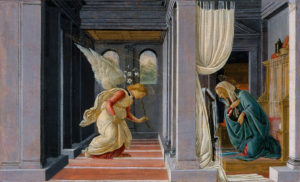By Carrie Wilson
I’m very grateful to be able to speak today about what I’ve learned from my study of Aesthetic Realism about a work of art I love and a question that is on every person’s mind: “What will make me happy?” At one time I was afraid I would never find out. I learned from Eli Siegel that happiness has a logic, and beauty has. It is he who understood both. That magnificent understanding, true about every work of art and every person, is in this Aesthetic Realism principle he stated: “All beauty is a making one of opposites, and the making one of opposites is what we are going after in ourselves.”
I once saw happiness as something the world took a special interest in denying me. Another way I looked at it was that my not being happy was a sign of my depth and sensitivity. But I also felt there must be something wrong with me—I ought to have been happy; I was ashamed I wasn’t. I visited the college psychiatrist once and told her this. And because she couldn’t explain what would make me happy, she acted as though I were crazy to think I ought to be. And then in 1969 I began to study Aesthetic Realism and to learn what beauty is—and also that nothing less than aesthetics will ever satisfy a person in life. “All happiness of a self,” Eli Siegel said, “is aesthetics.”
I am going to speak about a work by the 15th century Florentine master Sandro Botticelli. He is most famous for his paintings of The Birth of Venus
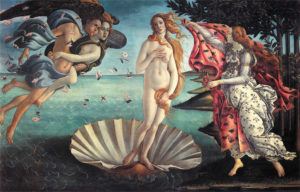
and La Primavera—Spring.

About 1490 he painted this Annunciation scene, now in the Metropolitan Museum of Art.
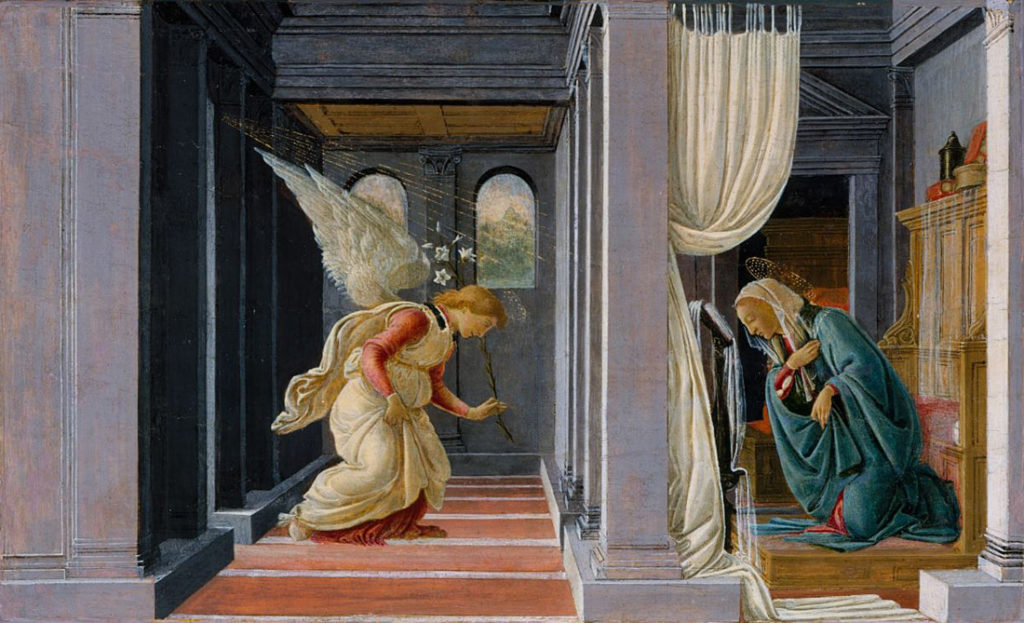
The museum catalogue describes this small panel—it is only 9 3/8” by 14 3/8”—as “One of the jewels of fifteenth-century Italian art.” As I thought about why I care for it so much, I came to see it makes a one of opposites we are trying to put together in ourselves, opposites on which our immediate and lasting happiness depends: the self separate and in relation, repose and energy, heaviness and lightness.
Self and World—Separation and Relation
The beginning opposites I’ve learned every person is trying to put together are self and world. Eli Siegel’s great essay “Art as Happiness,” published in The Right of Aesthetic Realism to Be Known, begins:
“Happiness is the sense of a right relation between oneself and the world of all time. To be alive is to have some of this sense; for a person is never wholly disconnected from, or in antagonism to, the world he’s in. Yet we also feel a separation from other things, an enmity to them, a lack of interest in them; and it is this that fights the always present feeling that somehow the world and ourselves are a true, pleasing, indissoluble pair.”
Botticelli’s painting depicts the moment when the angel Gabriel appeared to the Virgin Mary to tell her she would conceive a child by the Holy Spirit. The story of the Annunciation has been one of the most popular themes in all art because, I believe, it represents the hope in people for what Eli Siegel so beautifully described as “a sense of a right relation between oneself and the world of all time.” “The world,” he has said, “is the other half of ourselves.” The Virgin represents a self not yet fully in relation. The angel, the messenger of God, brings news of this relation.
What is remarkable, on first looking at Botticelli’s painting, is how strongly, with that row of columns, he asserts a separation between the angel and Mary—and yet how he makes us feel, at the very same time, their deep relation. We see them as “a true, pleasing, indissoluble pair.” How does he do this? First of all, the angel and the Virgin are the same size, and, as they bow to each other, their figures almost mirror each other. Gabriel and Mary are placed symmetrically on either side of the dividing columns, and at the same height. They do not look at each other, but they affect each other, respond to each other with deep respect. The angel kneels as he alights from his journey. Mary draws her garment in modesty before her, but she leans towards the angel. There is separation, but there is not the enmity or lack of interest Eli Siegel speaks of as fighting our sense of the world and ourselves as one.
The angel is mainly in white, and Mary in blue, yet beneath, they both wear garments of the same vibrant red. To be happy, I learned, we have to feel that our own depths are related to the outside world—to other people. Not long after I began my study of Aesthetic Realism, Eli Siegel asked me: “Which would you rather be, happy or important?” I began to see that the way I went after being important was against happiness. In his lecture, Aesthetic Realism as Happiness, Eli Siegel explains that when people think of happiness,
“…they think of having certain victories. There is no happiness without some kind of defeat, because if you are going to be happy it will mean that something outside of yourself is going to get you. If you can’t accept that, you might as well say bye-bye to happiness….The fight between the desire to be stuck-up, vain, to have oneself, and the desire to be happy, goes on in everyone.”
This vanity, the desire to have contempt for the world as a means of being important, makes for misery and cruelty, and did in me. We have to see that we are important through respect, through yielding to the meaning of the world, and that is what Botticelli shows.
Mary and the angel, the representative of God—whom Eli Siegel once described as “Reality insisting on a name”—are joined by the very thing that separates them. See how the top of the first column becomes the apex of a triangle whose sides pass diagonally through the two figures inclining toward each other. As Mary bows, the straight line of the triangle is in her form. She is part of something larger than herself. She yields to it and is strong.
Repose and Stir
In “Art as Happineses,” Eli Siegel writes:
“If one is happy, there must be in his life repose and stir. It is clear that repose by itself makes for boredom; and stir by itself makes for restlessness, uncertainty, fidgetiness. In the same way that happiness cannot be without repose and stir, so art cannot be.”
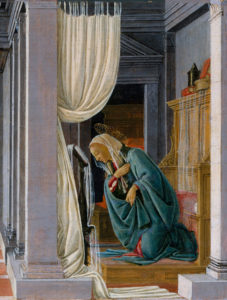 See how these opposites are in that amazing white curtain of the Virgin’s room. It drops, lifts, drops, doubles back, its soft curves meeting with surprising vigor the angular base of the pillar, and then it flows forth and is joined by the fall of a transparent cloth on the prayer stand.
See how these opposites are in that amazing white curtain of the Virgin’s room. It drops, lifts, drops, doubles back, its soft curves meeting with surprising vigor the angular base of the pillar, and then it flows forth and is joined by the fall of a transparent cloth on the prayer stand.
This transparent cloth is almost like water flowing from a fountain. It drops with speed, is halted, and then drops again—meeting the white curtain, which quietly spreads out horizontally across the floor to the base of the white pillar on the other side, where our eye makes an uninterrupted ascent to the height from which the curtain fell. This visual journey is beautiful.
“Happiness,” writes Mr. Siegel, “is the presence of repose and excitement at once, arising from reality adequately, courageously seen.” Here, an ordinary object, a curtain, is shown as having the motions of reality and the motions of our own lives within it—falling and rising, receding and going forth, repose and stir.
These same motions are in the beautiful angel Gabriel—descent and lift, restraint and assertion, quietude and energy. The ordinary and the wonderful are made akin. When we see this way, boredom and restlessness will not be with us.
Heaviness and Lightness
A tremendously important thing in my life was hearing Eli Siegel speak about the opposites in depression. He said that when a person is depressed they feel at once too light, empty, and also burdened, weighed down. Like other people, I had felt this way very often. Since studying Aesthetic Realism, I have never once been depressed. One way, I learned, I had invited unhappiness for myself was by the false lightness of mocking. In Botticelli’s painting, as in all art, lightness is arrived at through honoring substance and meaning.
In Eli Siegel’s great and definitive Fifteen Questions, Is Beauty the Making One of Opposites? he asks:
“Is there in all art, and quite clearly in sculpture, the presence of what makes for lightness, release, gaiety?—and is there the presence, too, of what makes for stability, solidity, seriousness?—is the state of mind making for art both heavier and lighter than that which is customary?”
Heaviness and lightness are one in every square inch of this painting. There is “lightness, release” in having an angel in white and red alight upon a red and white floor. Having an angel and the floor share the same colors makes spirit and matter, heaven and earth akin. And see how Botticelli weights this figure, giving him a black strip on each shoulder. Imagine the angel without this black. See how he becomes too light?
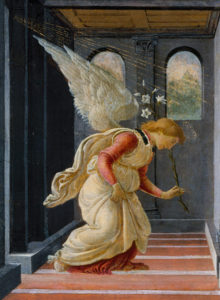
And look at his wings—don’t you feel volume, weight, at the same time as the lightness of feathers? Isn’t there, too, in the spray of lilies, lightness, release? Yet these white flowers, whose blooms seem to burst outward in joyous expression, have large meaning—they are symbolic of the Virgin’s purity. We can feel if we think deeply about things, give them their full weight of meaning, we’ll get bogged down. Art says this is not so: authentic lightness is the same as meaning.
The chief way heaviness and lightness are made one in this painting is through the architecture. By means of perspective, Botticelli gives this interior depth, increasing at once the solidity of the architecture and the sense of spacious lightness. The weightiest part of this painting is the massive outer wall on the left. The thickness of this wall makes the whole painting off-center.
Why did Botticelli do this? I was amazed to see that through it, all the opposites I have spoken of today are felt more intensely as one—self and world, separateness and relation, repose and stir, heaviness and lightness.
A. Hyatt Mayer, former curator at the Metropolitan Museum, writes:
“Botticelli shifts the pair of figures to the right of center so as to clear a space where the angel can enter, out of astral distances, for his implosion into the Virgin’s retirement.”
So a massive wall becomes equivalent to the space of “astral distances” the angel has traversed, and his being there so gracefully includes the energy of that journey and our awareness of his having broken through—as have those beams of light—“into the Virgin’s retirement.” This is what the separate, segregated ego of every person is hoping for. Fortunately, we don’t have to wait for an angel. I know from my own life that the honest seeing of our relation to the world, which Aesthetic Realism teaches, will make us happy and completely ourselves.
I close this talk with the last sentences of “Art as Happiness”:
“The museums of the world are guides to our happiness….Man will not be happy until he sees what he is, as such, where he begins. Then he will see, I think, that he is utterly neat particularity with tremendously rich relation….Art is happiness, and the soul or self of man is both. It is for him to see this, and to go on from there.”

